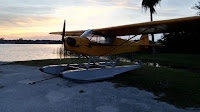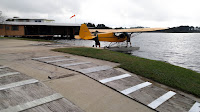First let me stress that his is NOT a trivial undertaking. There are many new complex ideas to be understood, lots of new terminology, and a totally new airplane to be learned. I was back in the student role once again and climbing the learning curve at my age just isn't as easy as it once was. Fortunately, Jon Brown has put together an excellent organization and his instructors and staff are all top notch. It was a fantastic experience.

The iconic Piper Cub is just a joy to fly. My first challenge was to climb into the machine. Although I got better at it, there is just no graceful way to get into the back seat. Once the instructor climbs in the forward visibility is gone. The student is left with some triangular slices of windscreen on either side of the instructors head, the tachometer on the left and altimeter on the right. Quite a change from the plethora of colorful information provided from Sally's panel. But it is enough. Look outside. Pick reference points. Look at the relationship of the wing to the horizon. Vx, Vy, V anything is 60kts. VSI is your gut. Inclinometer is your butt. Glorious. I love this plane.

The airport is nearly any lake you can see, and there are thousands of lakes in Florida. The runway is now a "Lane" and it can be in any direction. You land into the wind. Simple, but not easy. Gone is your primary reference, the asphalt runway with centerline and numbers. How do you determine the wind? How do you fly a good downwind? How do you handle different surface conditions?
The most challenging landing for me was the "Glassy Surface". When the water is smooth you lose all depth perception. The closest analogy is landing at night without a landing light, but even this comparison fails because the runway lights are there for peripheral vision. This is truly flying on faith into a black hole. The technique used is to set a pitch and power configuration at an "LVR" (Last Visual Reference) and wait (patiently) for the airplane to land. My brief summary makes it sound simple, it isn't.
I still get "check-itis". Sitting down in the office with Jon and taking the oral exam is an experience in itself. Fair but firm, he probed each area to insure I had at least the minimum amount of knowledge. I was worried that too many times my response was "I don't know", but finally he said let's go fly.
 He wasted no time. One maneuver to the next in rapid succession. Some went well, some others didn't. My crosswind landing was lousy. When we walked back in I didn't know and he gave no indication. "Let's debrief in my office." It was an acceptable flight. He said I was safe. "...and you nailed the glassy."
He wasted no time. One maneuver to the next in rapid succession. Some went well, some others didn't. My crosswind landing was lousy. When we walked back in I didn't know and he gave no indication. "Let's debrief in my office." It was an acceptable flight. He said I was safe. "...and you nailed the glassy."So now I am a Single Engine Seaplane pilot with a license to learn.
Jack Brown's Seaplane Base

